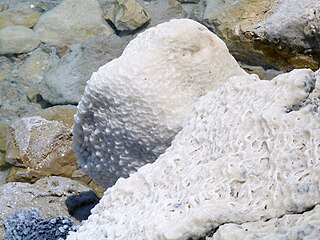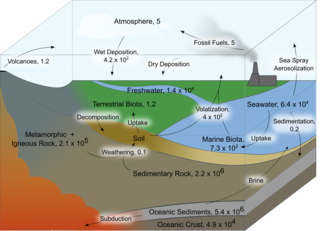Related Research Articles

Congenital iodine deficiency syndrome is a medical condition present at birth marked by impaired physical and mental development, due to insufficient thyroid hormone (hypothyroidism) often caused by insufficient dietary iodine during pregnancy. It is one cause of underactive thyroid function at birth, called congenital hypothyroidism, historically referred to as cretinism (obsolete). If untreated, it results in impairment of both physical and mental development. Symptoms may include goiter, poor length growth in infants, reduced adult stature, thickened skin, hair loss, enlarged tongue, a protruding abdomen; delayed bone maturation and puberty in children; and mental deterioration, neurological impairment, impeded ovulation, and infertility in adults.

A goitre, or goiter, is a swelling in the neck resulting from an enlarged thyroid gland. A goitre can be associated with a thyroid that is not functioning properly.

Hyperthyroidism is the condition that occurs due to excessive production of thyroid hormones by the thyroid gland. Thyrotoxicosis is the condition that occurs due to excessive thyroid hormone of any cause and therefore includes hyperthyroidism. Some, however, use the terms interchangeably. Signs and symptoms vary between people and may include irritability, muscle weakness, sleeping problems, a fast heartbeat, heat intolerance, diarrhea, enlargement of the thyroid, hand tremor, and weight loss. Symptoms are typically less severe in the elderly and during pregnancy. An uncommon complication is thyroid storm in which an event such as an infection results in worsening symptoms such as confusion and a high temperature and often results in death. The opposite is hypothyroidism, when the thyroid gland does not make enough thyroid hormone.

The thyroid, or thyroid gland, is an endocrine gland in vertebrates. In humans it is in the neck and consists of two connected lobes. The lower two thirds of the lobes are connected by a thin band of tissue called the thyroid isthmus. The thyroid is located at the front of the neck, below the Adam's apple. Microscopically, the functional unit of the thyroid gland is the spherical thyroid follicle, lined with follicular cells (thyrocytes), and occasional parafollicular cells that surround a lumen containing colloid. The thyroid gland secretes three hormones: the two thyroid hormones – triiodothyronine (T3) and thyroxine (T4) – and a peptide hormone, calcitonin. The thyroid hormones influence the metabolic rate and protein synthesis, and in children, growth and development. Calcitonin plays a role in calcium homeostasis. Secretion of the two thyroid hormones is regulated by thyroid-stimulating hormone (TSH), which is secreted from the anterior pituitary gland. TSH is regulated by thyrotropin-releasing hormone (TRH), which is produced by the hypothalamus.

Hypothyroidism is a disorder of the endocrine system in which the thyroid gland does not produce enough thyroid hormone. It can cause a number of symptoms, such as poor ability to tolerate cold, a feeling of tiredness, constipation, slow heart rate, depression, and weight gain. Occasionally there may be swelling of the front part of the neck due to goiter. Untreated cases of hypothyroidism during pregnancy can lead to delays in growth and intellectual development in the baby or congenital iodine deficiency syndrome.

Hashimoto's thyroiditis, also known as chronic lymphocytic thyroiditis and Hashimoto's disease, is an autoimmune disease in which the thyroid gland is gradually destroyed. Early on, symptoms may not be noticed. Over time, the thyroid may enlarge, forming a painless goiter. Some people eventually develop hypothyroidism with accompanying weight gain, fatigue, constipation, depression, hair loss, and general pains. After many years the thyroid typically shrinks in size. Potential complications include thyroid lymphoma. Furthermore, because it is common for untreated patients of Hashimoto's to develop hypothyroidism, further complications can include, but are not limited to, high cholesterol, heart disease, heart failure, high blood pressure, myxedema, and potential pregnancy problems.

Potassium iodide is a chemical compound, medication, and dietary supplement. It is a medication used for treating hyperthyroidism, in radiation emergencies, and for protecting the thyroid gland when certain types of radiopharmaceuticals are used. In the third world it is also used for treating skin sporotrichosis and phycomycosis. It is a supplement used by people with low dietary intake of iodine. It is administered orally.
Micronutrients are essential dietary elements required by organisms in varying quantities throughout life to orchestrate a range of physiological functions to maintain health. Micronutrient requirements differ between organisms; for example, humans and other animals require numerous vitamins and dietary minerals, whereas plants require specific minerals. For human nutrition, micronutrient requirements are in amounts generally less than 100 milligrams per day, whereas macronutrients are required in gram quantities daily.

Iodised salt is table salt mixed with a minute amount of various salts of the element iodine. The ingestion of iodine prevents iodine deficiency. Worldwide, iodine deficiency affects about two billion people and is the leading preventable cause of intellectual and developmental disabilities. Deficiency also causes thyroid gland problems, including endemic goitre. In many countries, iodine deficiency is a major public health problem that can be cheaply addressed by purposely adding small amounts of iodine to the sodium chloride salt.

Salt is a mineral composed primarily of sodium chloride (NaCl), a chemical compound belonging to the larger class of salts; salt in the form of a natural crystalline mineral is known as rock salt or halite. Salt is present in vast quantities in seawater. The open ocean has about 35 g (1.2 oz) of solids per liter of sea water, a salinity of 3.5%.
Iodine deficiency is a lack of the trace element iodine, an essential nutrient in the diet. It may result in metabolic problems such as goiter, sometimes as an endemic goiter as well as congenital iodine deficiency syndrome due to untreated congenital hypothyroidism, which results in developmental delays and other health problems. Iodine deficiency is an important global health issue, especially for fertile and pregnant women. It is also a preventable cause of intellectual disability.
Food fortification or enrichment is the process of adding micronutrients to food. It can be carried out by food manufacturers, or by governments as a public health policy which aims to reduce the number of people with dietary deficiencies within a population. The predominant diet within a region can lack particular nutrients due to the local soil or from inherent deficiencies within the staple foods; the addition of micronutrients to staples and condiments can prevent large-scale deficiency diseases in these cases.

Kashin–Beck disease (KBD) is a chronic, endemic type of osteochondropathy that is mainly distributed from northeastern to southwestern China, including 15 provinces. As of 2011, Tibet has the highest incidence rate of KBD in China. Southeast Siberia and North Korea are other affected areas. KBD usually involves children ages 5–15. To date, more than a million individuals have had KBD. The symptoms of KBD include joint pain, morning stiffness in the joints, disturbances of flexion and extension in the elbows, enlarged inter-phalangeal joints, and limited motion in many joints of the body. Death of cartilage cells in the growth plate and articular surface is the basic pathologic feature; this can result in growth retardation and secondary osteoarthrosis. Histological diagnosis of KBD is particularly difficult; clinical and radiological examinations have proved to be the best means for identifying KBD. Little is known about the early stages of KBD before the visible appearance of the disease becomes evident in the destruction of the joints.
Selenium deficiency occurs when an organism lacks the required levels of selenium, a critical nutrient in many species. Deficiency, although relatively rare in healthy well-nourished individuals, can have significant negative results, affecting the health of the heart and the nervous system; contributing to depression, anxiety, and dementia; and interfering with reproduction and gestation.

Iodine is an essential trace element in biological systems. It has the distinction of being the heaviest element commonly needed by living organisms as well as the second-heaviest known to be used by any form of life. It is a component of biochemical pathways in organisms from all biological kingdoms, suggesting its fundamental significance throughout the evolutionary history of life.

Although it is toxic in large doses, selenium is an essential micronutrient for animals. In plants, it sometimes occurs in toxic amounts as forage, e.g. locoweed. Selenium is a component of the amino acids selenocysteine and selenomethionine. In humans, selenium is a trace element nutrient that functions as cofactor for glutathione peroxidases and certain forms of thioredoxin reductase. Selenium-containing proteins are produced from inorganic selenium via the intermediacy of selenophosphate (PSeO33−).

China National Salt Industry Corporation, abbreviated as China Salt, is a state-owned enterprise of China which controls a monopoly over the management and production of edible salt. The company employs 48,476 workers, and controls assets worth 44.19 billion yuan as of 2011.
The Iodine Global Network describes itself as a "non-profit, non-government organization for the sustainable elimination of iodine deficiency worldwide."

Creswell John Eastman is the Clinical Professor of Medicine at Sydney University Medical School, Principal of the Sydney Thyroid Clinic and Consultant Emeritus to the Westmead Hospital. Eastman is an endocrinologist and has directed or conducted research and public health projects into elimination of iodine deficiency disorders (IDD) in Malaysia, Indonesia, Laos, Cambodia, Thailand, several Pacific Islands, Hong Kong, China and Tibet and Australia. For his work in remote areas of China, he has been dubbed the "man who saved a million brains".
Child health and nutrition in Africa is concerned with the health care of children through adolescents in the various countries of Africa. The right to health and a nutritious and sufficient diet are internationally recognized fundamental human rights protected by international treaties and conventions on the right to life, as well as in charters, strategies and declarations. Millennium Development Goals (MDGs) 1, 4, 5 and 6 highlight, respectively, how poverty, hunger, child mortality, maternal health, the eradication of HIV/AIDS, malaria, tuberculosis and other diseases are of particular significance in the context of child health.
References
- ↑ Piccone, N (2011). "The Silent Epidemic of Iodine Deficiency". Life Extension. 17 (10): 42–51.
- 1 2 World Health Organization. "Nutrition—Micronutrient Deficiencies: Iodine Deficiency Disorders". Archived from the original on April 16, 2008. Retrieved 23 March 2012.
- ↑ Li, S; et al. (2010). "Is the current iodine content in edible salt appropriate for eliminating iodine deficiency in China". Asia Pacific Journal of Clinical Nutrition. 19 (2): 231–5. PMID 20460237 . Retrieved 23 March 2012.
- ↑ Moreno-Reyes, R; et al. (1998). "Kashin–Beck Osteoarthropathy in Rural Tibet in Relation to Selenium and Iodine Status". The New England Journal of Medicine . 339 (16): 1112–1120. doi: 10.1056/NEJM199810153391604 . PMID 9770558. S2CID 2485235.
- ↑ DeLong, R; et al. (1997). "Effect on infant mortality of iodination of irrigation water in a". The Lancet. 350 (9080): 771–773. doi:10.1016/S0140-6736(96)12365-5. PMID 9297997. S2CID 8169226.